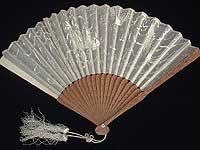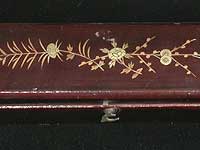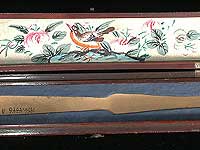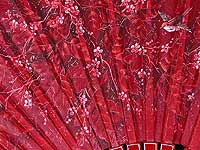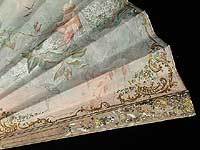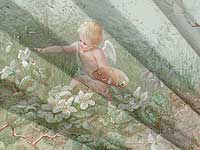Cool Breezes: Handheld Fans
in Fashion, Art and Advertising
BEST IN SHOW
Fans of the Milwaukee Elite

Embroidered Silk Fan and Box, 1900-1920
Manufactured in China. Silk, sandalwood. Gift of Mrs. Gregory Mason.
Wisconsin Historical Museum object # 1956.4346,a
Embroidered Silk Fan and Box, 1900-1920
This fan belonged to Eliza (Eliot) Fitch (1865-1955) of Milwaukee, Wisconsin. Eliza and her husband Grant Fitch, an officer of the National Exchange Bank, were described as "leading lights" of Milwaukee society in her obituary.
The fan shown here represents a typical form of Chinese export fan with its embroidered Chinese floral motifs and carved sandalwood sticks. Usually fans made for export were not as well carved as those meant for use in China, though the embroidery was still expertly done. These imported fans usually came in a lacquered wooden box. Those with a fitted cardboard slot, such as the one for this fan, were considered the deluxe model.

Painted Silk Gauze Fan, ca. 1885
Silk, paint, wood, leather. Gift of Sarah Allis.
Wisconsin Historical Museum object # 1945.652
Painted Silk Gauze Fan, ca. 1885
By the late 19th century, fans were generally mass-produced in factories and were available for people of all social backgrounds. Wealthy women could distinguish themselves by using more expensive handmade, hand-painted fans. Sarah Esther (Ball) Allis (1853-1945) of Milwaukee, Wisconsin, the wife of Allis-Chalmers Company founder's son Charles Allis, did just that with this elegant fan of hand-painted red silk gauze and leather-covered guards and sticks.

Painted Paper Fan, ca. 1900
Manufactured in France. Paper, paint, mother-of-pearl. Gift of Lorraine Goodrich McDermott.
Wisconsin Historical Museum object # 1956.1187
Painted Paper Fan, ca. 1900
Maria Philipine (Pabst) Goodrich (1868-1947) of Milwaukee, Wisconsin used this fan. She was the daughter of Frederick Pabst, founder of Pabst Brewing Company, and the wife of William Osborn Goodrich, an opera singer and owner of a Milwaukee linseed oil business. In 1956 Maria's daughter Lorraine cleaned out her parents' house following William's death. She found this fan during the cleaning and donated it to the Wisconsin Historical Society.
L. Stouder, the painter of this fan, signed it in the lower left corner. She may have worked for the Parisian firm of Duvelleroy or one of its Parisian competitors, since painters for upscale fan manufacturers usually signed their work.

Cabriolet Feather Fan, 1880-1900
Himalayan monal feathers, tortoise shell celluloid. Gift of Isabelle Chapman Miller.
Wisconsin Historical Museum object # 1952.38
Cabriolet Feather Fan, 1880-1900
Invented in the mid-18th century, cabriolet fans looked like the wheels of cabriolets, two-wheeled, single horse carriages that bumped up and down like young goats (capriolas).
These fans, with their extra holes, let women survey a room without appearing to be doing so.
This fan is made from the feathers of the Himalayan monal, a pheasant found in India, Pakistan, and Nepal. Monals, which wear several different colors of iridescent feathers, have been bred in northern India for centuries. Laura (Bowker) Chapman (1828-1909) of Milwaukee, Wisconsin, the wife of Timothy A. Chapman, founder of T.A. Chapman's Department Store, could afford a fan made from such exotic feathers.

